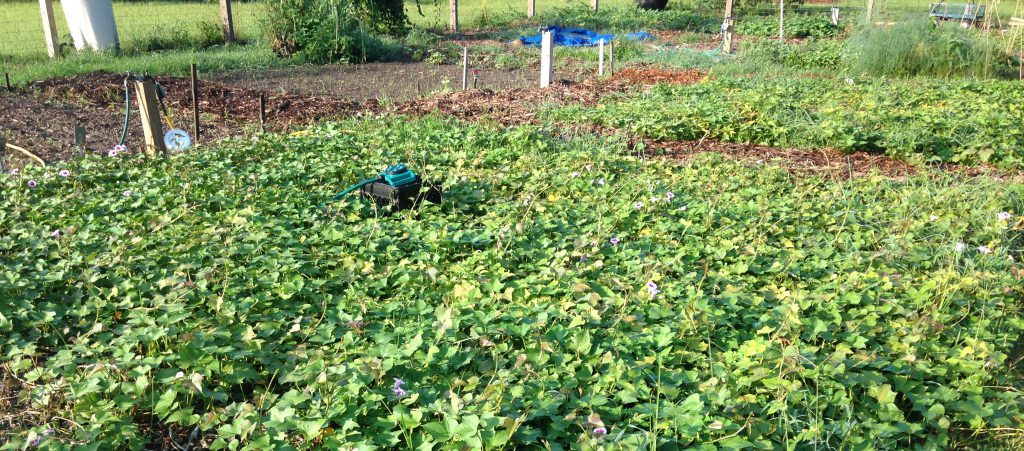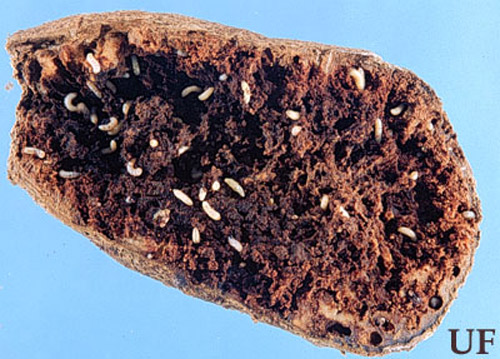Written by: De’Anthony Price, Agriculture & Natural Resources Extension Agent, UF/IFAS Extension – Jefferson County
Florida is the perfect place to grow sweet potatoes (Ipomea batatas). Sweet potatoes are considered a long-season crop, and Florida’s long, hot summers allow them to grow and mature well here.
Sweet potatoes are native to America and known for their colorful and tasty tubers. Their flesh can be yellow, orange, or even purple. They are a great source of vitamins A and C. Sweet potatoes are an excellent warm-season crop for Florida. They require a long growing season but will reward you greatly for your patience. The leaves are edible as well. Not only are they nutritious, but the young leaves and shoots also provide a source of tender and mild-tasting leafy greens through the hot Florida summer. Sweet potatoes are a healthier alternative to white potatoes with a high glycemic index. The starch from a white potato is quickly metabolized, leading to a rapid increase in blood sugar. Sweet potato starches are metabolized at a slower rate.

Planting and Care
Sweet potatoes can be planted in the spring through the end of June. Sweet potatoes grow in a well-drained loamy to sandy soil and do not require much fertilizing. If the soil contains clay, add some aged compost or other organic amendments to the planting bed to improve drainage. Sweet potatoes grown in unamended clay soils are usually small.
Sweet potatoes are generally planted from March through June in the Florida Panhandle. Sweet potatoes are typically started from transplants called “slips.” Sweet potato slips are six to eight-inch sweet potato vine cuttings with most of the leaves pulled off. You can purchase sweet potato slips from a local garden center or a seed catalog. Make sure you only buy certified, disease-free slips. One can also quickly start your sweet potato slips from a store-bought sweet potato. Sweet potato weevils can be a severe problem and starting with certified-free transplants can help you avoid issues.

Plant sweet potatoes in rows spaced 48 to 54 inches apart, with 12 to 14 inches between each plant. Look for transplants that are about 6 to 9 inches long. Sweet potatoes will do best when they receive a consistent water supply; inconsistent watering can cause them to split while growing. Sweet potatoes can be kept throughout the season using vine cuttings to create new plants.
Wireworms and root-knot nematodes are the biggest problems for home gardeners. However, many insect and disease problems can be avoided by choosing disease-resistant varieties and using sound cultural gardening practices. Crop rotation with a vegetable in another family can help prevent nematode and soil disease. Rotating where you plant can help prevent problems with a major pest, the sweet-potato weevil (Cylas formicarius).

For the tastiest sweet potatoes, always dig up the previous crop and start a new planting. While sweet potatoes can be grown year-round in tropical regions, plants left to grow for too long can encourage pest populations. The sweet potatoes eventually become too large and tough for most people’s tastes.
Florida-friendly varieties
‘Centennial’ and ‘Beauregard’ are two varieties that grow well in Florida gardens. Beauregard is found quite often in garden centers. It shows some disease resistance and produces a high yield. It has light rose skin and a deep orange flesh that matures in 105 days. Centennial sweet potatoes tolerate clay soil, are disease resistant, and mature in 90 days.
Harvest and Storage
Sweet potatoes should be ready to harvest 90–120 days after planting. The tops will die back as it gets close to harvest time. Sweet potatoes should be harvested before the first frost. Cool soil reduces their quality and storage life. Sweet potato skin is fragile, so freshly dug roots need to be handled gently.
The ideal conditions for curing sweet potatoes are roughly 85°F with 90 percent humidity. To help increase their sweetness, place harvested sweet potatoes in a dark, warm room for at least two weeks before eating. Once your sweet potatoes are done curing, store them in a cool, dry pantry—not the refrigerator! Storing your sweet potatoes at temperatures below 50°F can cause them to have an off flavor or rot. Patience will pay off with delicious and healthy sweet potatoes that can be added to the dinner plate as a vegetable side or in a sweet pie served for dessert. While “yam” is sometimes used to describe the sweet potato, a true yam comes from a different plant.
- Zinnias 101 - April 11, 2024
- Jefferson County Pollinator Teaching and Demo Garden - February 29, 2024
- Native Fruit Trees – The Common Persimmon - November 2, 2023
